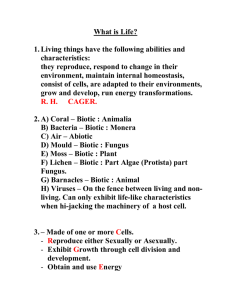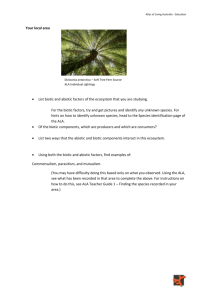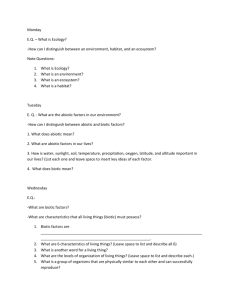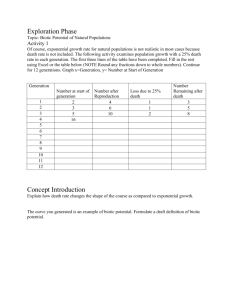Keywords: biological oxygen demand, biotic index
advertisement
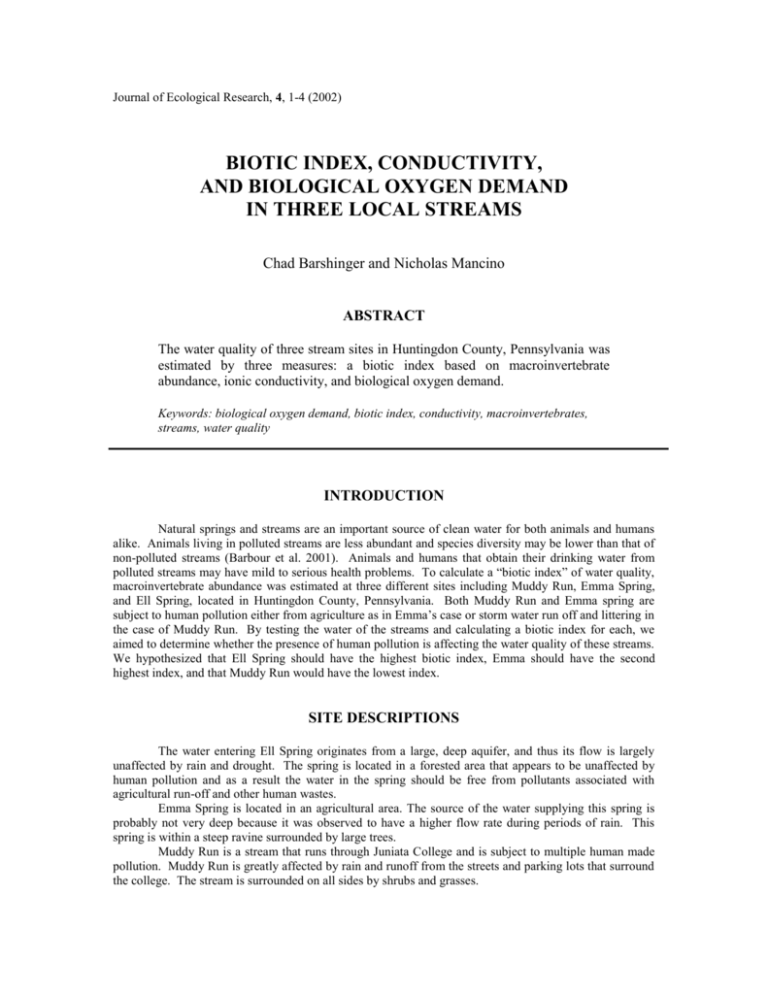
Journal of Ecological Research, 4, 1-4 (2002) BIOTIC INDEX, CONDUCTIVITY, AND BIOLOGICAL OXYGEN DEMAND IN THREE LOCAL STREAMS Chad Barshinger and Nicholas Mancino ABSTRACT The water quality of three stream sites in Huntingdon County, Pennsylvania was estimated by three measures: a biotic index based on macroinvertebrate abundance, ionic conductivity, and biological oxygen demand. Keywords: biological oxygen demand, biotic index, conductivity, macroinvertebrates, streams, water quality INTRODUCTION Natural springs and streams are an important source of clean water for both animals and humans alike. Animals living in polluted streams are less abundant and species diversity may be lower than that of non-polluted streams (Barbour et al. 2001). Animals and humans that obtain their drinking water from polluted streams may have mild to serious health problems. To calculate a “biotic index” of water quality, macroinvertebrate abundance was estimated at three different sites including Muddy Run, Emma Spring, and Ell Spring, located in Huntingdon County, Pennsylvania. Both Muddy Run and Emma spring are subject to human pollution either from agriculture as in Emma’s case or storm water run off and littering in the case of Muddy Run. By testing the water of the streams and calculating a biotic index for each, we aimed to determine whether the presence of human pollution is affecting the water quality of these streams. We hypothesized that Ell Spring should have the highest biotic index, Emma should have the second highest index, and that Muddy Run would have the lowest index. SITE DESCRIPTIONS The water entering Ell Spring originates from a large, deep aquifer, and thus its flow is largely unaffected by rain and drought. The spring is located in a forested area that appears to be unaffected by human pollution and as a result the water in the spring should be free from pollutants associated with agricultural run-off and other human wastes. Emma Spring is located in an agricultural area. The source of the water supplying this spring is probably not very deep because it was observed to have a higher flow rate during periods of rain. This spring is within a steep ravine surrounded by large trees. Muddy Run is a stream that runs through Juniata College and is subject to multiple human made pollution. Muddy Run is greatly affected by rain and runoff from the streets and parking lots that surround the college. The stream is surrounded on all sides by shrubs and grasses. METHODS AND MATERIALS At each of the three sites, pH and conductivity were measured using electronic meters. Maximum and minimum water temperatures during a 24-h day were estimated at each site using max-min thermometers. Collection of species for the biotic index was done by drawing out a map of each site and dividing that map into grid areas. The areas were then numbered and a random numbers table was used to select the grid area in which to obtain a sample, using a core sampler. Five samples from each site were taken. Macroinvertebrates were later counted and identified in the laboratory using taxonomic keys. The number of animals of each taxon collected at each site was used to calculate a biotic index of water quality at that site (following Anonymous 1999). This index weights the abundance of taxa according to their sensitivity to pollution. RESULTS The biotic index of each stream tended to be inversely correlated with conductivity (r2 = 0.9684, P = 0.114) and biological oxygen demand (r2 = 0.9549 P = 0.136), although neither association was significant (Figs. 1 & 2). Table 1 shows the number of organisms of various macroinvertebrate taxa collected at each site, as well as the total number collected and the calculated biotic index). Table 2 shows the various physical measurements taken at each site. Table 1. Number of individuals of various taxa collected at each of the three study sites, as well as the calculated biotic index for each site. Ell Spring Emma Spring Muddy Run Taxa Amphipods Trichoptera Tipulidae Fontigens nickliniana Empididae Chironomidae Ephemeroptera Planaria Oligochaeta Leech Gyrinidae Lymnaeidae Copepod Plecoptera Totals Biotic Index 22 8 3 133 1 1 1 0 0 0 0 0 0 0 169 344 178 15 3 0 0 9 0 6 0 0 0 0 0 0 211 428 0 0 1 0 0 0 9 0 14 3 1 1 1 1 30 53 Table 2. Physical measurements taken at each of the three study sites. Physical Data Spring Muddy Run Ell Spring Emma Spring pH 7.54 7.58 6.76 Conductivity 436 260 148.9 Biological Oxygen Demand (mg O2/mL) Temperature Max/Min (C) 0.7 18.5/13.0 0.31 9.0/8.5 0.03 10.0/9.0 Biotic Index vs. Conductivity Biotic Index 500 400 300 200 R2 = 0.9684 100 0 0 100 200 300 400 500 Conductivity (microSiemens) Figure 1. Association between the biotic index and the conductivity of the water at each of three stream sites. Biotic Index vs. Biological Oxygen Demand 500 Biotic Index 400 300 200 R2 = 0.9549 100 0 0 0.2 0.4 0.6 0.8 Biological Oxygen Demand (mg 02/ml) Figure 2. Association between the biotic index and the biological oxygen demand of the water at each of three stream sites. DISCUSSION Our prediction was partly correct in that Muddy Run had the lowest biotic index. However, Emma Spring had a higher biotic index than Ell Spring. The biotic index seems to be affected by both the biological oxygen demand and conductivity, as there is a strong (but nonsignificant) correlation between these measurements and the biotic index. Another factor that may have an effect on the macroinvertebrate life are the maximum and minimum temperatures. Muddy Run has a significantly higher temperature than both Ell and Emma Spring, which may have affected the abundance of various invertebrates living there. ACKNOWLEDGEMENTS We thank Dr. Glazier for his support, guidance, and equipment. We also thank Melanie Vrabel for estimating the biotic oxygen demand of our water samples. LITERATURE CITED Anonymous. 1999. Biological Indicators. <http://fluvarium.ca/bioticindex.html >. Accessed April 18, 2002. Barbour, M.T., J. Gerritsen, B.D. Snyder and J.B. Stribling, JB. 2001. Rapid bioassessment protocols for use in streams and wadeable rivers: periphyton, benthic macroinvertebrates, and fish. <http://www.epa.gov/owow/monitoring/rbp/ >. Accessed April 02, 2002.


